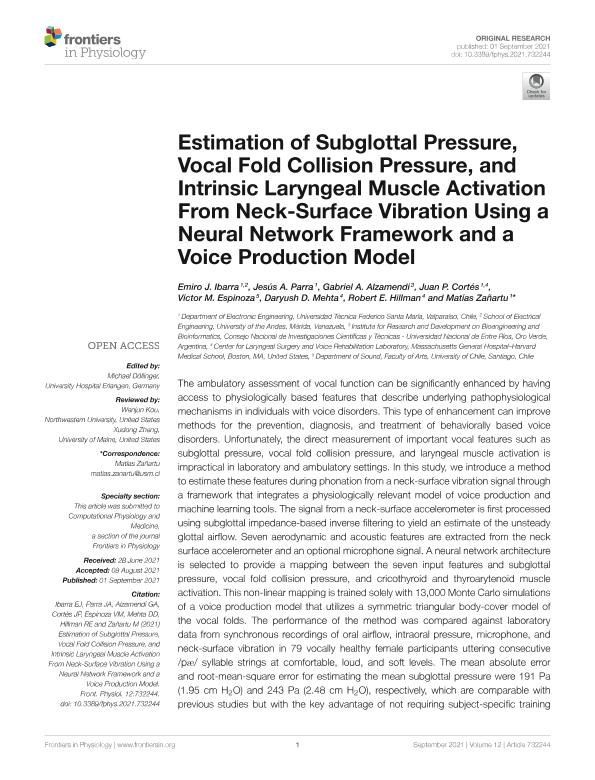Artículo
Estimation of Subglottal Pressure, Vocal Fold Collision Pressure, and Intrinsic Laryngeal Muscle Activation From Neck-Surface Vibration Using a Neural Network Framework and a Voice Production Model
Ibarra, Emiro J.; Parra, Jesús A.; Alzamendi, Gabriel Alejandro ; Cortés, Juan P.; Espinoza, Víctor M.; Mehta, Daryush D.; Hillman, Robert E.; Zañartu, Matías
; Cortés, Juan P.; Espinoza, Víctor M.; Mehta, Daryush D.; Hillman, Robert E.; Zañartu, Matías
 ; Cortés, Juan P.; Espinoza, Víctor M.; Mehta, Daryush D.; Hillman, Robert E.; Zañartu, Matías
; Cortés, Juan P.; Espinoza, Víctor M.; Mehta, Daryush D.; Hillman, Robert E.; Zañartu, Matías
Fecha de publicación:
09/2021
Editorial:
Frontiers Media
Revista:
Frontiers in Physiology
ISSN:
1664-042X
Idioma:
Inglés
Tipo de recurso:
Artículo publicado
Clasificación temática:
Resumen
The ambulatory assessment of vocal function can be significantly enhanced by having access to physiologically based features that describe underlying pathophysiological mechanisms in individuals with voice disorders. This type of enhancement can improve methods for the prevention, diagnosis, and treatment of behaviorally based voice disorders. Unfortunately, the direct measurement of important vocal features such as subglottal pressure, vocal fold collision pressure, and laryngeal muscle activation is impractical in laboratory and ambulatory settings. In this study, we introduce a method to estimate these features during phonation from a neck-surface vibration signal through a framework that integrates a physiologically relevant model of voice production and machine learning tools. The signal from a neck-surface accelerometer is first processed using subglottal impedance-based inverse filtering to yield an estimate of the unsteady glottal airflow. Seven aerodynamic and acoustic features are extracted from the neck surface accelerometer and an optional microphone signal. A neural network architecture is selected to provide a mapping between the seven input features and subglottal pressure, vocal fold collision pressure, and cricothyroid and thyroarytenoid muscle activation. This non-linear mapping is trained solely with 13,000 Monte Carlo simulations of a voice production model that utilizes a symmetric triangular body-cover model of the vocal folds. The performance of the method was compared against laboratory data from synchronous recordings of oral airflow, intraoral pressure, microphone, and neck-surface vibration in 79 vocally healthy female participants uttering consecutive /pæ/ syllable strings at comfortable, loud, and soft levels. The mean absolute error and root-mean-square error for estimating the mean subglottal pressure were 191 Pa (1.95 cm H2O) and 243 Pa (2.48 cm H2O), respectively, which are comparable with previous studies but with the key advantage of not requiring subject-specific training and yielding more output measures. The validation of vocal fold collision pressure and laryngeal muscle activation was performed with synthetic values as reference. These initial results provide valuable insight for further vocal fold model refinement and constitute a proof of concept that the proposed machine learning method is a feasible option for providing physiologically relevant measures for laboratory and ambulatory assessment of vocal function.
Archivos asociados
Licencia
Identificadores
Colecciones
Articulos (IBB)
Articulos de INSTITUTO DE INVESTIGACION Y DESARROLLO EN BIOINGENIERIA Y BIOINFORMATICA
Articulos de INSTITUTO DE INVESTIGACION Y DESARROLLO EN BIOINGENIERIA Y BIOINFORMATICA
Citación
Ibarra, Emiro J.; Parra, Jesús A.; Alzamendi, Gabriel Alejandro; Cortés, Juan P.; Espinoza, Víctor M.; et al.; Estimation of Subglottal Pressure, Vocal Fold Collision Pressure, and Intrinsic Laryngeal Muscle Activation From Neck-Surface Vibration Using a Neural Network Framework and a Voice Production Model; Frontiers Media; Frontiers in Physiology; 12; 9-2021; 1-13
Compartir
Altmétricas



